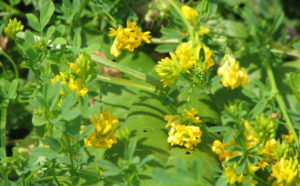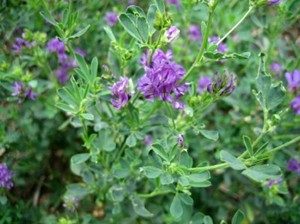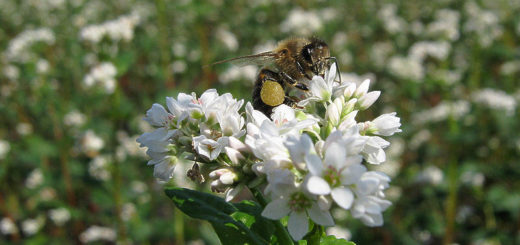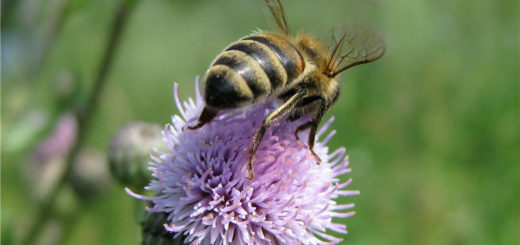honey plant Lucerne

honey plant Lucerne
Lyutserka as a honey plant: species, medoproduktivnost.
alfalfa (Medicago) – genus of annual and perennial herbaceous plants, belonging to the legume family and combine 103 species.
Used in agriculture, beekeeping and medicine.
Distributed in CIS, during the Soviet era was very popular and occupies a large area.
From the position of the stems are often polukustarnyky, reaching up to one meter of a strong root system.
This important quality alfalfa helps to independently provide themselves with necessary substances.
Like all Bean on the ends of root tubers are, promoting recycling and accumulation of nitrogen, and saturation of its land.
Given this quality is often planted to enrich the soil nutrients for the yield of other crops.
Across the surface of leaf shoots are, located on the leg (chereshkovі), threes. The shape of a circle or oval.
At the top of the leaf axils and are kistoobrazne inflorescence, cylindrical, close 25 buds.
Papilionaceous corolla consists of five petals, latest, the lowest pair is connected and contains stamens and pistils. Colors include shades of purple and yellow, sometimes mixed.
Bloom starts through 2 months after sowing and continues to 4 weeks. Pollination is possible only with insects, after formation of fruits in form of brown beans – brown.
The shape is similar to a sickle or curled, located inside the small seeds, yellow – brown.
Types of alfalfa
Lucerne has more than a hundred species. The most famous such types, how: yellow alfalfa, sickle, alfalfa hmelepodibna, blue alfalfa crop, Hybrid alfalfa variable.
However undergo examination honey crop alfalfa and sickle.
Alfalfa Seed
Read: White and yellow acacia honey plant as: productivity.
Alfalfa Seed (Medicago sativa L.) represents a kustoobraznu plant, with fleshy leaves. Stems straight, elongated and reach a height of almost 100 cm.
According to the structure leaves it difficult, consisting of a central plate and two side plates.

A honey plant alfalfa crop
She unusual beautiful flowers, which are similar in appearance with butterflies. From that happens their name, butterfly.
This type is characteristic for all members of the legume family Fabaceae and subfamily, which is the alfalfa.
Their color ranges from purple to purple.
The fruit is a spiral alfalfa zakruchuyuyuchisya fruit.
Distributed in central and southern part as crops, sometimes growing independently, wildly.
Anatomical structure of this flower, that bee collecting nectar must try.
The stamens grow alfalfa crop with a pestle, all this creates a body called column.
This column is surrounded by a kind of shuttle, the internal edges of petals by inserting projections.
Gland, producing nectar is located in the heart of this mechanism, so hard to reach for bees.
However, If the bee still perform pollination, then a couple of hours alfalfa crop petals lose their original appearance and crumbling.
Nectar of the flower has no color and containing about fifty percent sugar. It flowers in early summer, with 10. 000 square meter may collect from 20 -100, sometimes comes to 300 kg.
It is known for its high yield as fodder plants and more or less unassuming nature.
Often used by breeders to enter other plants strengths alfalfa, This resistance to drought, cold and salty soil.
In folk medicine useful in the treatment of diabetes and thyroid diseases. However, high doses can give the opposite, dangerous effect.
Read: Coriander like honey plant: growth and productivity.
Alfalfa yellow crescent
Alfalfa yellow crescent (Medicago falcate L.) is a perennial. At the height can reach 60 cm.
Has many stems, without hair or with a small number of them, which reach a height.
leaves are small, ovoyidnoyi form, the same type of sickle. Cones are located on the elongated axis, stalks at approximately the same length.

Lucerne as a yellow sickle honey plant
The whole picture is more like a brush or brush, hence the name inflorescence – brush.
Colors common to all shades of yellow.
The shape of the flower resemble sickle and therefore more accessible for bees.
However, Use this type of alfalfa can only large apiaries with strong families after certain manipulations, must accustom bees.
Flowering begins from mid-summer and lasts until its end. The fruits ripen in late summer and early September, outside the small crescent or less straightened form, with a little fuzz.
Nectar in the alfalfa quite fussy. Most sugar content it has only the length of time between an hour and four hours of the day.
The temperature should not be less than twenty-six and thirty degrees above, and the humidity level stay 50 – 60%.
Overnight chemical composition is changing nectar, example, from lunch until five in the evening significantly reduced blood glucose, on the plant less attractive to bees.
Observe, after the first mass gathering in early summer bees pollinate more actively in its mid-summer.
The bees from apiaries open every fortieth flower, when every second wild. Beekeeping bees make greater emphasis is on nectar, wild and collect more pollen.
Read: Bruise as a honey plant: medoproduktivnost, flowering.
medoproduktivnost
Importantly! WITH 10 000 square meter may collect from 20 to 300 kg of honey.
Well experiencing frost and cold, loves prefers moist, but the summer heat is quite viable.
Often used to save the soil from erosion. Live long enough, to ten years. After leaving himself good, fertile soil.
Also used in folk medicine as a sedative, analgesic and anti-inflammatory agent. Infusion of inflorescences used in cough.
Alfalfa honey and its beneficial properties
Alfalfa honey has many shades, just starting and ending with transparent amber.
At the time of sugaring is white, thick, consistency is somewhat reminiscent of cream or sour cream.
Rapid crystallization ensured high sugar content. However, if the temperature is high enough, honey virtually impossible crystallization.

Lyutserka honey
Feature! Bee product production from alfalfa crop has a pleasant aroma with subtle notes of mint, peculiar only to him specific aftertaste.
Honey yellow crescent lyutserky organoleptic parameters identical seeding.
Bee product production from alfalfa has many nutrients, vitamins, micronutrients, sugars, enzymes, organic acids.
It contains such substance, as levuleza. It is actively used in diseases of the heart muscle, strengthens blood vessels and lowers blood pressure.
Well promotes recovery from ARI and influenza, prevent disease and re-development of complications.
It has anti-inflammatory properties and is therefore used in inflammatory diseases of the upper respiratory tract and as an expectorant.
It promotes the secretion of bile settlement, disease biliary system, liver.
Also excellent promotes healing of small wounds, burns skin, Copes with rashes and boils on the skin.
digestible product, which consume each day for treatment and prevention.
Read: Sunflower as honey plant: when in bloom, productivity.
Indications and contraindications
Indications alfalfa honey:
- Acute viral respiratory infections. Strengthens overall immunity and resistance.
- Burns and no deep wounds. Improves regeneration and suspends secondary inflammation;
- Diseases of bile formation: liver, gallbladder. It stimulates the production of bile and improves digestion;
- The disease of the gastrointestinal tract. Well absorbed in the stomach;
- Cardiovascular disease. Prevents stroke and myocardial infarction. Also useful for varicose veins.
Importantly! Contraindications to use is allergic to honey and hypersensitivity to bee products.
Equally undesirable for people suffering from obesity and diabetes.
Lyutserka, as a honey plant, used by many experienced beekeepers.
Experts value the plant for the opportunity to get more healthy and tasty product.



